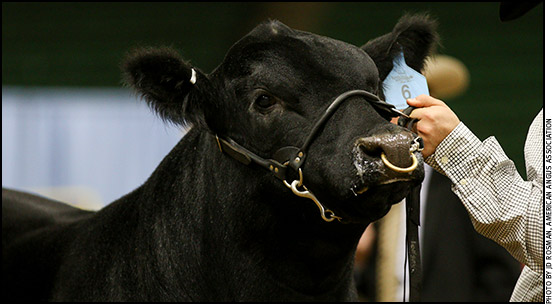MANAGEMENT...

Simplifying Bull Selection on Sale Day
Oklahoma State University’s Mark Johnson shares tips for how buyers can find the bull that best complements their herd.
It is crucial to evaluate the needs of your ranch before making bull selections. The genotype of an animal is just one part of a much larger system. Factors included in the bull selection process should be the genetics of your animals, the physical production environment, fixed resources, management, production inputs and marketing end points. Select the traits and performance levels that make sense for your ranch and profits will increase.
That was the advice of Mark Johnson, associate professor of animal science at Oklahoma State University, as he presented ideas for simplifying bull selection on sale day to attendees of the 2017 Angus Convention in Fort Worth, Texas. Johnson presented his comments Nov. 5 during an Angus University educational breakout session that included two presentations on using expected progeny differences (EPDs). Read more.

Justin Sexten
Disposition: convenience or performance trait?
We often consider temperament a convenience trait. When looking for bulls to use, we study pedigrees, pictures, performance data and, now, videos until we develop a list of prospective herd sires. The final call before bidding: Is he docile enough? Replacement heifer candidates will follow a similar pattern with “attitude” being a deciding factor after you consider many other traits.
Even if it’s the last thing you think about at decision time, recent work at Texas A&M suggests disposition affects performance at many points in development.
Researchers sorted heifers from the same ranch into excitable and calm groups based on exit speed from the chute after processing. Like most evaluations by default, that sort produced a group of “fast” or excitable heifers. Interestingly, cattle in this experiment were fed in the same pens, so performance was comparable between these groups within the same environment. Read more.
Don’t Let Vaccines Freeze in Cold Weather
Keep vaccines at a consistent temperature to ensure efficacy.
Cold weather can make things more challenging when vaccinating cattle. Russ Daly, Extension veterinarian and associate professor at South Dakota State University, says one important consideration when working cattle in cold temperatures is to be careful to not let vaccines freeze — whether you’re working with a modified-live virus (MLV) or a killed product.
No matter what type of vaccine you’re using, it shouldn’t be allowed to freeze. The modified-live viruses will be inactivated by freezing, and the vaccine will no longer be potent, he explains. It won’t be able to stimulate an immune response, so you would essentially be wasting your time vaccinating those animals. Read more.
Select Fertile Heifers
Reproductive success in the first breeding season sets the stage for lifetime productivity.
If heifers have not reached puberty and cycled before the breeding season, they may be set up for failure as 2-year-olds, cautioned David Patterson, professor of animal science and beef extension specialist for the University of Missouri–Columbia. During an Angus University educational breakout session at the 2017 Angus Convention in Fort Worth, Texas, Patterson explained to producers the importance of selecting fertile heifers.
Weight alone cannot determine if a heifer has reached puberty and is ready to be bred, he emphasized. While age and weight at puberty are heritable traits that have proven to be consistent over time, there are other things to look at before making the assumption a heifer is ready to breed. Read more.

Kris Ringwall
Beef Talk
Stability seen in long-term trends for beef growth performance.
The North Dakota State University (NDSU) Extension Service and North Dakota Beef Cattle Improvement Association (NDBCIA) collect and analyze data through Cow Herd Appraisal of Performance Software (CHAPS) to produce meaningful annual benchmarks. The current growth benchmark for actual weaning weight is 554 pounds (lb.) at 192 days of age, with an average daily gain of 2.5 lb. These calves are a 5.2 frame score.
The NDBCIA uses the CHAPS program to calculate five-year rolling benchmark values for average herd performance. Those values have been quite consistent. Let’s look closer at the average actual weaning weight benchmark. Read more.
New Products
Industry affiliates provide a wide array of products and services to assist you on the farm and ranch. Here’s an assortment of new products to hit the market recently.
- Open-station tractor
- Gas-powered utility vehicles
- Wide pickup square balers
- Gas-powered utility vehicle
- Calf digestive health support
Angus Advisor
Click here for December herd management tips from cattle experts across the nation. Advice separated by region.
[Click here to go to the top of the page.]







